Iveco Daily
The Iveco Daily is a large light commercial van produced by the Italian automaker Iveco since 1978; it was also sold as the Fiat Daily by Fiat until 1983. Unlike the more car-like unibody Fiat Ducato, the Daily uses a separate ladder frame typical of heavier commercial vehicles. The Iveco Daily is produced at the Iveco Suzzara plant, near Mantova in Italy, where Iveco has recently made substantial investments to renew the production lines.
| Iveco Daily | |
|---|---|
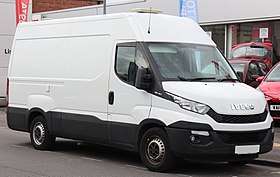 | |
| Overview | |
| Manufacturer | Iveco |
| Also called | Iveco EcoDaily Only first generation: Fiat Daily (until 1983) OM Grinta Alfa Romeo AR8 Zastava Rival Irisbus EcoDaily |
| Production | 1978–present |
| Assembly | Suzzara, Mantova, Italy Valladolid, Spain Boumerdes, Algeria (IVAL)[1] Nanjing, China |
| Designer | Luan Hasnay (first generation) |
| Body and chassis | |
| Class | Light commercial vehicle/Van (M) |
| Body style | Van Minibus Pickup truck |
| Chronology | |
| Predecessor |
|
| Successor | Fiat Ducato (for Fiat Daily and other first generation rebadges) |
The Daily is also the longest-running vehicle of the Iveco production and in over 40 years have sold over 3 million examples. Today it is marketed in 110 markets around the world.[2]
First generation (1978–1992)
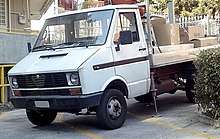
The first series Daily was offered with two models, the 35 and the 50 (3.5 and 5.0 tons). The larger one (Daily 50) had load capacity up to 17 m³. In 1985, a turbodiesel version named "TurboDaily" was introduced.[3] An Alfa Romeo badge engineered version was sold as the Alfa Romeo AR8, similarly to the Fiat Ducato based AR6. The OM version was initially called OM Grinta, and later the turbocharged version OM TurboGrinta.[4] In Switzerland, these were also sold as Saurer-Fiat and as Saurer-OM.[5]
Engines[6]
- 2.5l diesel 72 hp (54 kW) at 4200 rpm, 141 N⋅m (104 lb⋅ft) at 2400 rpm
- 2.5l turbodiesel 95 hp (71 kW) at 4100 rpm, 217 N⋅m (160 lb⋅ft) at 2300 rpm
- 2.5l diesel I.D. 75 hp (56 kW) at 4200 rpm, 160 N⋅m (118 lb⋅ft) at 2200 rpm (only in Zastava Rival)
Second generation (1990–2000)
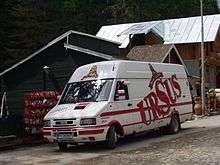

The second generation Daily was introduced in 1990, with a totally revised cab and improvements on the Sofim engine (at that time, with a 2.5 L capacity). Following the entry of Ford's commercial operation into Iveco, in 1986, The Daily 3.5 ton was soon removed from the UK market as it was now direct competition with Ford's Transit, the Daily stayed on in the UK at rated above 4.0 ton, and now sold as Iveco-Ford Truck. The Daily has no other connection with the Transit.
The second generation was facelifted in 1996; it differs only slightly exterior-wise, but the engine was now available in 2.8-litre capacity 76 KW (103 hp). The 59-12 (chassis cabs and panel vans) and 59-13 (minibus) models were launched (GVW 6.4 tons). All-wheel-drive variants were also made available.
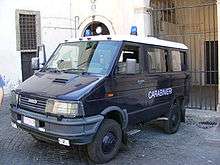
Engines
- 2.5l diesel 75 hp (56 kW) at 4,200 rpm
- 2.5l turbodiesel 103 hp (77 kW) at 3,800 rpm
- 2.5l tdi 116 hp (87 kW) at 3,800 rpm
- 2.8l diesel 85 hp (63 kW)
- 2.8l turbodiesel 103 hp (77 kW) at 3,600 rpm
- 2.8l tdi 122 hp (91 kW) at 3,600 rpm
Third generation (2000–2006)
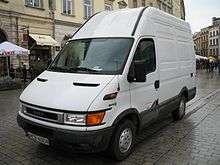
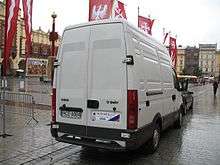
With third series the Daily got new light groups (wider and lower). The Turbodaily name was dropped as all turbodiesels came with Unijet technology (common rail). Two new versions were released: "Agile", with automatic gearshift, and "CNG", a natural gas version. Also two new load classes were introduced: Daily 65 and Daily 28 (6.5 tons and 2.8 tons). The Iveco Daily was made "Van of the Year" for the year 2000.
The third generation of the Iveco Daily and the second generation of the Renault Mascott share many panels and some components of the cab, including the doors due to an agreement between Iveco and Renault stipulated in July 1994. The agreement provided for the production and sharing of common components for a total of 120 thousand pieces a year produced in the various factories of Brescia (Italy, Iveco), Suzzara (Italy, Iveco), Valladolid (Spain, Iveco) and Batilly (France, SoVAB Renault factory).[7]
Engines
Originally there were models with three engine options, all of type 8140 of 2.8 liters. A variant was a suction diesel with 66 kW (90 hp), but they rarely sold. Another had turbocharger, intercooler and 78 kW (106 hp). The last variant gave 92 kW (125 hp) and had common rail injection. Shortly after receiving the largest engine variable geometry turbocharger and an output of 107 kW (146 hp).
In 2003 came F1A engine with 2.3 litre stroke volume and second-generation common rail injection with 74 kW (101 hp) and 88 kW (120 hp), and in 2004 came the new F1C engine of 3.0 liters, based on F1A with timing chain and 100 kW (136 hp) or 122 kW (166 hp). At this time, the old 8140-engine was completely replaced.
Transmissions
The motors up to 88 kW (120 hp) had five-speed gearbox, while the more powerful engines also available with a six-speed gearbox. The model could also be obtained with electronic / hydraulic controlled manual gearbox, called Agile.
Fourth generation (2006–2011)
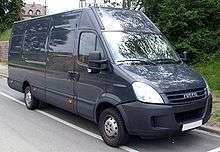

The fourth generation was designed by Giugiaro and arrived to markets in the middle of 2006. It's available as: Van, cabin cruiser, Combi, Minibus, Agile, and CNG. The minibus is also commercialized with the Irisbus brand. Certain models with clean engines have been sold as the "Iveco EcoDaily" in some European markets.[8]
For the first time since the year 2000, an all-wheel-drive version of the Daily is available starting from 2007. This is developed in co-operation with the company SCAM and is available as single cab and double cab with the wheelbases 3,050 mm (120 in) and 3,400 mm (130 in) and double cab with wheelbase of 3,400 mm (130 in). Permissible total weight in two versions: 3,500 kg (7,700 lb) or 5,500 kg (12,100 lb).
Engines
- 2.3 HPI 96 PS (71 kW; 95 hp) and 116 PS (85 kW; 114 hp)
- 2.3 HPT 90 PS (66 kW; 89 hp)diesel
- 3.0 HPI 146 PS (107 kW; 144 hp)
- 3.0 HPT 176 PS (129 kW; 174 hp)
- 3.0 CNG 136 metric horsepower (100 kW)
Fifth generation (2011–2014)
| Iveco Daily | |
|---|---|
| Overview | |
| Manufacturer | Iveco |
| Production | 2011-2014 2017-present (Iveco Daily Ousheng) |
| Body and chassis | |
| Class | Light commercial vehicle (M) |
| Body style | Van Minibus Pickup truck |
| Powertrain | |
| Engine | 2.3 diesel 3.0 diesel |
| Transmission | 6-speed manual 6-speed semi-automatic[9] |
The fifth generation was introduced 29 June 2011 and came into the market at the beginning of September 2011.[10]
Iveco Daily Ousheng
_Daily_Ousheng_Tourist_RV.jpg)
A version produced by Naveco (Nanjing Iveco) of China called the Iveco Daily Ousheng (欧胜) was a facelift based on the fifth generation Iveco Daily,[11] and extended production starting from 2017.[12]
Engines
Euro 5
- 2,3 l 78 kW (106 PS)/270 Nm
- 2,3 l 93 kW (126 PS)/320 Nm
- 2,3 l 107 kW (146 PS)/350 Nm
- 3,0 l 107 kW (146 PS)/350 Nm
- 3,0 l 126 kW (170 PS)/400 Nm
- 3,0 l 150 kW (205 PS)/470 Nm
EEV
- 3,0 l 107 kW (146 PS)/370 Nm
- 3,0 l 126 kW (170 PS)/400 Nm
- 3,0 l CNG 100 kW (136 PS)/350 Nm[13]
Sixth generation (2014–present)
| Iveco Daily | |
|---|---|
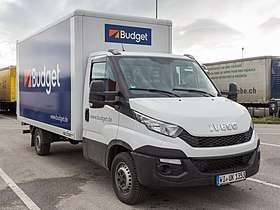 | |
| Overview | |
| Manufacturer | Iveco |
| Production | 2014-present |
| Body and chassis | |
| Class | Light commercial vehicle (M) |
| Body style | Van Minibus Pickup truck |
| Powertrain | |
| Engine | 2.3 JTD 3.0 JTD and CNG |
| Transmission | 6-speed manual 6-speed semi-automatic 8-speed ZF 8HP automatic |
| Dimensions | |
| Wheelbase | 3000-3950 mm |

The sixth generation was introduced in July 2014.
Electric version
A version powered by a 30 kW (40 HP) electric motor (60 kW peak) supplied by a battery with a capacity of 76 Ah and 21.2 kWh was announced in August 2010.[15]
Variants
- 40.10 WM (4 x 4) 1,500 kg light truck series - Officially the VM 90 is the square body military version of the Daily and includes an armored variant.
References
- https://www.autobip.com/actualite_auto/usine_iveco_algerie_debut_de_production_de_commercialisation_des_vehicules/4968 Missing or empty
|title=(help) - "Iveco Daily celebrates 40 years of success". Iveco. 20 July 2018. Retrieved 4 January 2019.
- "Vieni, c'è una casa tutta da guidare nell'anno che verrà". La Repubblica. 8 September 1984. Retrieved 9 January 2019.
- "Nozze europee tra Iveco e Ford". La Repubblica. 31 December 1985. Retrieved 9 January 2019.
- Rohrbach, Hans U., ed. (1982), Internationaler Nutzfahrzeug-Katalog (Inufa) 1982 [International Commercial Vehicle Catalog] (in German), 24, Solothurn, Switzerland: Vogt-Schild AG, p. 214
- Duško, Terzić; Nestorović, Emilija; Putnik, Svetozar; Kačar, Saša; Jovičić, Vladimir; Janjić, Ana; Ristić, Miljko (3 May 2018). "Hirurško liječenje infekcije sa apscesnom formacijom izlaznog mjesta kabla za napajanje uređaja za potporu rada ljeve komore". Scripta Medica. 49 (1): 57–60. doi:10.18575/msrs.sm.s.18.09. ISSN 2303-7954.
- "Accordo di collaborazione tra Iveco (Fiat) e Renault". La Repubblica. 26 July 1994. Retrieved 9 January 2019.
- "Iveco EcoDaily". whatvan. Retrieved 22 March 2013.
- "Nuovo furgone Iveco Daily". Iveco.com. Retrieved 30 May 2017.
- "New Daily – a new hero for transport professionals". web.iveco.com. Retrieved 24 September 2011.
- "南京依维柯-依维柯Daily(欧胜)".
- "推三种车型 依维柯Daily 11月4日上市".
- "Performance ed efficienza - Iveco Daily furgone". Iveco.com. Retrieved 30 May 2017.
- http://www.iveco.com/Italy/collections/catalogues/Documents/New-Daily/Cat-Daily-Van-IT.pdf
- "ECODAILY Electric motor". Sales material. Iveco UK. 2010. Retrieved 18 July 2010.